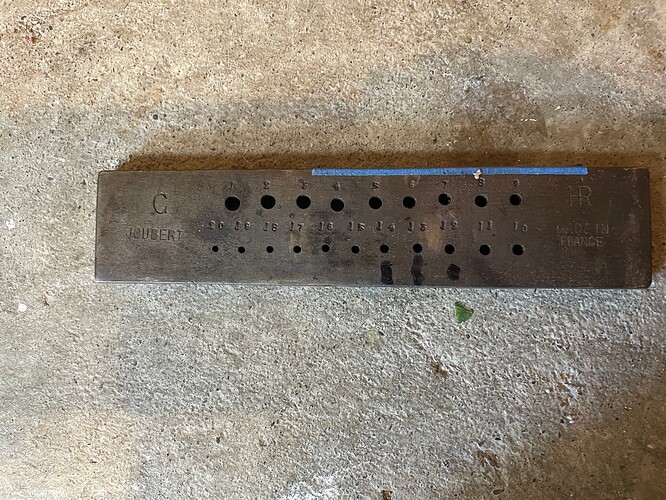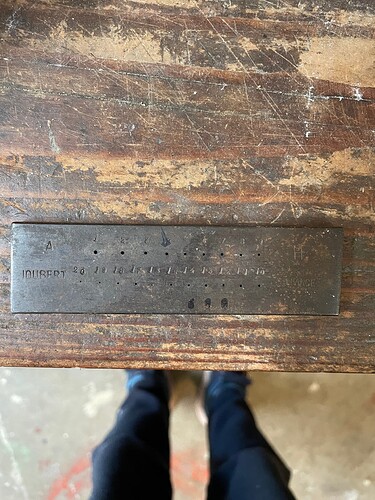I’m cleaning out a friend’s studio and he had several Joubert (French) round draw plates. These are marked A, B, and C. Each has 20 holes. Does anyone know what the hole sizes are for these plates? The overall size for the plates is 4 1/4" x 1 1/4" for the A plate, 5" x 1 1/4" for the B plate and 5 1/2" x 1 1/4" for the C plate. Any idea what they might be worth? I haven’t found any references to them online. Thanks!
I could never connect the numbers on my draw plates with the gauge wire that I wanted. I just started keeping track in a table as I used them. Someone else may have a better idea…Rob
I am sorry. I am not of any help either. I have two very old draw plates of Indian or Pakistani manufacture. There are no sizes marked either.
Don
My Italian draw plates (from Otto Frei) are engraved with the size range in the upper right corner, though it is a bit cryptic.
For two oval-profile plates that are 3 mm to 1 mm, and 6 mm to 3 mm the engraved code reads 30.A.10 and 60.A.30. The pattern holds for other sizes. Insert a decimal point before the zero and you have the millimeters of the largest and smallest holes. I have no idea what the A stands for.
My plates are numbered 1 - 30 or 1 - 31 etc. and those just indicate the progression from larger to smaller. For the plate that goes from 1 mm to 3 mm (a 2 mm span) in 30 steps, then each step would be a little under 0.07 mm smaller or larger than the one next to it.
Rob’s idea of measuring the drawn wire and keeping a record of each thickness per hole is a good one, otherwise keep a wire gauge tool on hand.
I don’t know if this will work but it might… if you have a large set of calibrated drills, you could stick the chuck end of the drill into the holes to size them… at least the results should be close. Convert the size of the drill either from millimeters or fractions of an inch in to gauge by using a conversion table avaiable on line. Confirm the gauge by doing a draw and using an accurate caliper to measure the wire.
Make a vertical table that starts with the biggest hole number in your draw plates and ends with the smallest. Cut a piece of the thickest piece of wire that you have and progressively draw it through the holes from biggest to smallest. Anneal as needed. write down the wire gauge and thickness in inches and mm for each hole. I have a couple of different round wire draw plates and there is nothing standard that I can find about what the number on the hole means. Save this table in a place where you will remember where it is. That is the hardest step for me. Good luck…Rob
I think the poster’s question is more "What is the resale value of used Joubert drawplates?’ than “How can I tell what size wire they produce?” So, probably 1/2 to 1/3 the price of a new drawplate. Gesswein has sets of three plus a half-round plate for $99.50 to $115.95. Start there.
You’re right in that the second question was: “how much are they worth?” and we didn’t answer it. I just missed the question. I have no idea what they are worth. There are a number of jewelry tool resale FB groups and other websites. I guess, in the end, they are worth what someone is willing to pay for them. Thanks…Rob
Thanks everyone! There were two questions (sorry about that). I really like the idea of using the graduated drill bits, then keeping a table. I’m also glad to know that there doesn’t seem to be an easy correspondence to the label on the hole and gauge…I thought perhaps I was missing something. As for price, I agree that starting at the 1/3 to 1/2 price would be good – I was hoping someone knew something about Joubert and the relative quality of the draw plates. I’m guessing that they are pretty good quality as they are old and French…
refer to the thread on this topic from 2002 in our website… Joubert and Pellerin draw plates were made in France and were expensive. Very high quality… Italians made cheaper ones and put them out of business… Italian plates were of lesser quality.


